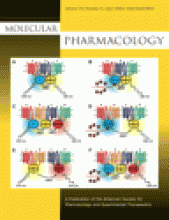Abstract
The heptahelical G protein-coupled receptors (GPCRs) must reach their correct subcellular location to exert their function. Receptor domains relevant for receptor trafficking include signal sequences mediating receptor integration into the membrane of the endoplasmic reticulum (ER) and anterograde or retrograde transport signals promoting receptor sorting into the vesicles of the secretory pathway. In addition, receptors must be correctly folded to pass the quality control system of the early secretory pathway. Taking the endothelin B receptor as a model, we describe a new type of a transport-relevant GPCR domain. Deletion of this domain (residues Glu28 to Trp54) leads to a fully functional receptor protein that is expressed at a lower level than the wild-type receptor. Subcellular localization experiments and glycosylation state analyses demonstrate that the mutant receptor is neither misfolded, retained intracellularly, nor misrouted. Fluorescence recovery after photobleaching analyses demonstrate that constitutive internalization is also not affected. By using an in vitro prion protein targeting assay, we show that this domain is necessary for efficient translocon gating at the ER membrane during early receptor biogenesis. Taken together, we identified a novel transport-relevant domain in the GPCR protein family. Our data may also be relevant for other GPCRs and unrelated integral membrane proteins.
Footnotes
-
This work was supported by the Deutsche Forschungsgemeinschaft [Grant SFB 449].
-
M.A. and A.S. contributed equally to this work.
-
ABBREVIATIONS: GPCR, G protein-coupled receptor; ETBR, endothelin B receptor; ET-1, endothelin-1; EndoH, endoglycosidase H; ER, endoplasmic reticulum; ERAD, endoplasmic reticulum-associated degradation pathway; FRAP, fluorescence recovery after photobleaching; GFP, green fluorescent protein; LSM, laser scanning microscopy; PAGE, polyacrylamide gel electrophoresis; PBS, phosphate-buffered saline; PMSF, phenylmethylsulfonyl fluoride; PNGaseF, peptide N-glycosidase F; PK, proteinase K; PrP, hamster prion protein; RM, canine pancreatic rough microsomal membranes; ROI, region of interest; SP, signal peptide; SRP, signal recognition particle; HEK, human embryonic kidney; PBS-I, CaCl2, MgCl2, KCl, NaCl, KH2PO4, Na2HPO4, phenylmethylsulfonyl fluoride, benzamidine, trypsin inhibitor, aprotinin, bacitracin, and bovine serum albumin.
-
↵1 Current affiliation: Charité-Universitätsmedizin Berlin, Biomedizinisches Forschungszentrum CVK, Berlin Germany.
- Received August 27, 2008.
- Accepted January 9, 2009.
- The American Society for Pharmacology and Experimental Therapeutics
MolPharm articles become freely available 12 months after publication, and remain freely available for 5 years.Non-open access articles that fall outside this five year window are available only to institutional subscribers and current ASPET members, or through the article purchase feature at the bottom of the page.
|






